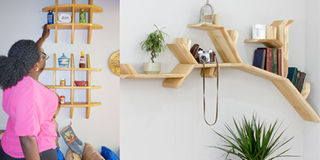Getting it right with shelves

Shelves help maximise storage in limited space. Photos by Phionah Nassanga
What you need to know:
- With shelves, Rwezi says you are able to bring order into your home, from the kitchen to the living room.
Creating and maintaining an effective storage area in your house can be challenging, especially if you have limited space with lots to store.
Emily Rwezi of ZOE Ceative Interiors, says when given a right touch, shelves are a design element and a point of attraction in your home. To Rwezi, shelves give you a chance to turn unusable spaces such as corners into places of attraction with design and style. When buying a shelf, you need to put different factors into consideration.
Style
When it comes to choosing the style of your shelf whether for your living room, bathroom or any other place, look out for something that suits your choice of décor. This can be a corner shelf, globe cross shelf, tube shelf, depending on what you wish to use it for.
Size
Size is perhaps the most important factor to consider when shopping for shelves. It determines the function for which you are buying the shelf, keeping in mind the space to place it. Consider the height; look at the space between shelves and then its thickness: this tells you what to occupy it with.
Material
Shelves are made from a variety of materials, namely, wood, metal, plastic and glass. Wooden shelves offer an African traditional elegance; they are long lasting and good for heavy weights. However, glass is delicate and not suitable for heavy items.
Styles to choose from
Globe cross shelves
“One may opt to import them or buy those that are locally made because they are stronger,” Rwezi explains. Plus, globe cross shelves vary in size depending on what you want to use them for. They are available in all colours.
She says they are hang on walls, thus adding a classic element to your home décor. Globe cross shelves are a perfect addition to your bedroom, for holding your perfumes cosmetics, jewellery box and can also be used in any other room depending on the size and purpose.
Corner shelves
Shanir Ssewanga, a carpenter, says corners are often overlooked and underutilised. But corner shelves are good, especially for people with limited space.
These can be used anywhere in the house: in the kitchen, living room or bathroom to gain storage for your collections.
He says these are built at a right angle and can be wall hang or floor based.
Standing shelves
These are ideal for both display and storage purposes.
“Standing shelves are portable and can be easily shifted to any place of choice. This type of shelf also comes with sufficient space,” Ssewanga says.
Standing shelves are available in a range of sizes, materials, colours and designs.
Hanging shelves
These are adaptable and organised. Rwezi says hanging shelves are commonly used in pantry areas.
Supported by hooks, this makes them adjustable compared to shelves that are just fitted to the wall. These can be made of metal, wood, grass and can be bought in a wide range of sizes and styles.
Why you may need a shelf
Display your personality
Evelyn Ninsiima, an artist and interior designer, says shelves provide the best space for you to put your personality, sharing items that reflect your interests and hobbies. She adds, “You can do this by choosing the perfect shelf style to complement your house.”
Enhance your space
A floor-to-ceiling shelving unit can enhance a small space, when well arranged and perfectly placed.
According to Ninsiima, you can dedicate a wall for your new hanging bookshelf and reorganise things in your space to enable you keep the majority of your items on the different shelves and thereby free up room for other items like furniture.
Organise your clutter
With shelves, Rwezi says you are able to bring order into your home, from the kitchen to the living room.
Shelves hold a variety of things you can place within eyesight for ease access.
This also gives you a chance to organiSe and where possible incorporate some design elements like ornaments.
“To make the most of your shelves, you will have to determine how they will be used, what to place in them and where to locate them.”




